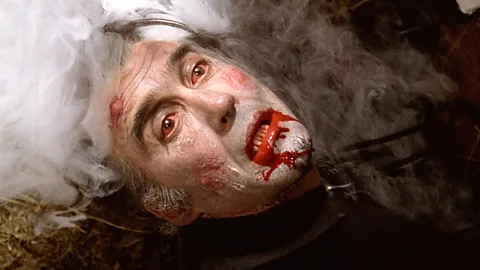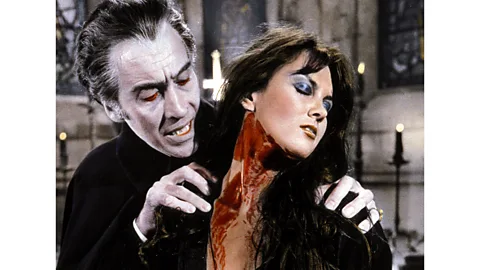The bizarre Dracula film that saw him meet the hippies
 Getty Images
Getty ImagesFifty years ago, Dracula AD 1972 saw the Count wreak havoc in swinging 1970s London – and was roundly derided by critics. But it changed the template for the iconic bloodsucker, writes David Barnett.
The tag-line of Dracula AD 1972 pretty much says it all: "The count is back, with an eye for London's hot pants… and a taste for everything!" Normally to be found haunting the shadowy castles and alleys of 19th-Century Europe, the iconic bloodsucker in this British horror cult classic instead wreaks havoc in London in the latter half of the 20th Century – the first time, really, that Dracula had been taken out of his Victorian milieu, and placed in a contemporary setting.
Released in cinemas 50 years ago, the movie came at the twilight of UK film company Hammer Productions' famed horror output, which began in 1955 with The Quatermass Experiment and had its heyday from the latter part of that decade until the late 1960s.
Much like its earlier US counterpart Universal Studios, Hammer assembled a stable of the classic horror monsters to bring to celluloid life – the mummy, Frankenstein's monster, werewolves –but with a British sensibility, and more gore and sex. For many cinemagoers, Christopher Lee's red-eyed Count Dracula became the archetypal big-screen incarnation, beginning with 1958's Dracula, a more-or-less straight adaptation of Bram Stoker's 1897 novel. By the time of Dracula AD 1972, however, Hammer had gone – in this case extremely – off-piste with their continuing chronicles of the Transylvanian villain.
 Alamy
AlamyWith the twin Hammer pillars of Lee and his regular sparring partner Peter Cushing, who played vampire hunter Abraham Van Helsing, headlining Dracula AD 1972, it seemed destined for success, even with Lee – in his penultimate outing as Dracula, his last being the loose follow-up The Satanic Rites of Dracula – reportedly being less than enthusiastic about the film. In his 2004 autobiography Lord of Misrule, Lee – while avowing a strong iration for the character of the Count – wrote: "It was aesthetically depressing to see the films step by step deteriorate… with The Satanic Rites of Dracula I reached my irrevocable full stop."
The movie begins in typical Dracula-movie fashion, with a frantic chase as Cushing's vampire hunter Abraham Van Helsing pursues Lee's Transylvanian Count in 1872, eventually impaling him in novel fashion on a broken carriage wheel, dying himself in the process. One of popular culture's greatest hero-villain dynamics is finally over. But as one of Dracula's followers buries his ashen remains near Van Helsing's grave in London's St Bartolph's Church he glances to the sky… and suddenly a enger jet flies overhead, segueing the story rather neatly to a hundred years' hence. And here, in 1972, we find a brooding Christopher Neame as Johnny Alucard (a cunning nom-de-plume that absolutely none of his friends thinks to say backwards), a hippie disciple of the undead count whose mission is to bring Dracula back in order to wreak havoc on Swinging London.
Not even Dynasty star Stephanie Beacham, playing both an acquaintance of Alucard and a descendant of Dracula's nemesis Van Helsing, twigs what's up with him – even when, following a prolonged party scene soundtracked by the 1970s blues-rock band Stoneground (apparently Rod Stewart and the Faces were at one point in the frame to be the live band on screen), Alucard takes her and their bored hippie crew off to St Bartolph's Church to perform a Satanic rite for a bit of a laugh. Which does, of course, bring Dracula back in rude health and – as the tag-line says – with an eye for hot-pants… not to wear them himself, of course, but to chomp into their owners.
"This isn't a terrific rationale for another horror flick but, given Miss Beacham's ability to heave, and her bosom to heave with, it will have to do," wrote the famed and feared film critic Roger Ebert on the movie's release in 1972. He also, somewhat curiously, praised it with faint damnation by bemoaning the fact that Hammer "now seems willing to follow the artistic leads of violence-come-latelies like Kubrick. Alas". Meanwhile, the Monthly Film Bulletin said it was "an abortive and totally unimaginative attempt to update the Bram Stoker legend to present-day Chelsea". These were typical of the reviews at the time, which followed on from the derisory notices also given to Hammer's previous Dracula movie, Scars of Dracula. It seemed that, certainly in reviewers' minds, Hammer's custodianship of Bram Stoker's creation had become anaemic by the time AD 1972 was released.
A case for the defence
"Hammer's Dracula films weren't generally well-reviewed anyway – and fans tended then to be stuffy about innovations," says Kim Newman, novelist, writer and film critic. "It was the first Hammer Dracula I saw in a cinema and I loved it – I saw it again on television later in the 1970s and thought it was hopelessly dated. I've since warmed up to it again … AD 1972 has its kitsch/camp elements, but the action scenes are terrific, the characters are vivid and engaging, and I like the score." What Dracula AD 1972 did also, in plucking the Count out of his period setting, and bringing him bang up to date, should not be underestimated.
 Alamy
AlamyAnother big fan of the film is the writer, actor and Sherlock co-creator Mark Gatiss, whose 2020 BBC TV miniseries about the Count with Sherlock collaborator Steven Moffat pulled a similar trick. It placed Dracula (played with menacing charm by Claes Bang) in his original context and then, midway through the story, turned everything on its head by having him surface in the modern day. Gatiss couldn't be more effusive about Dracula AD 1972, flaws and all. "It's such a joyful thing and I'm so glad it exists," he says. "I’ve always loved this film, principally because it's so wrong. It has a wonderful naffness to it, and I think that comes from the fact they originally planned to make it in 1969, but by the time they released it in 1972, the hippy thing was already so dated."
He adds that its seemingly maverick premise was true to the spirit of Bram Stoker's novel because that itself offered an updating of the vampire story from its traditional home in several-centuries-old legends. "People often forget how radical the original novel is," he says. "Dracula comes to England for new horizons, new blood, his land is old and dead, and what became the standard setting for Dracula adaptations, Victorian England, was new and contemporary at the time." Neverthless, like Newman too, Gatiss thinks the follow-up, The Satanic Rites of Dracula, which keeps Dracula in the modern era, this time going up against secret service agents, is a better film, "gritty and very creepy", and perhaps a more fitting send-off for Lee's career as the titular bloodsucker. "I don't think Christopher Lee was very happy with Dracula AD 1972 at all," Gatiss adds. "If you look at publicity photos from the film, he looks so miserable!"
